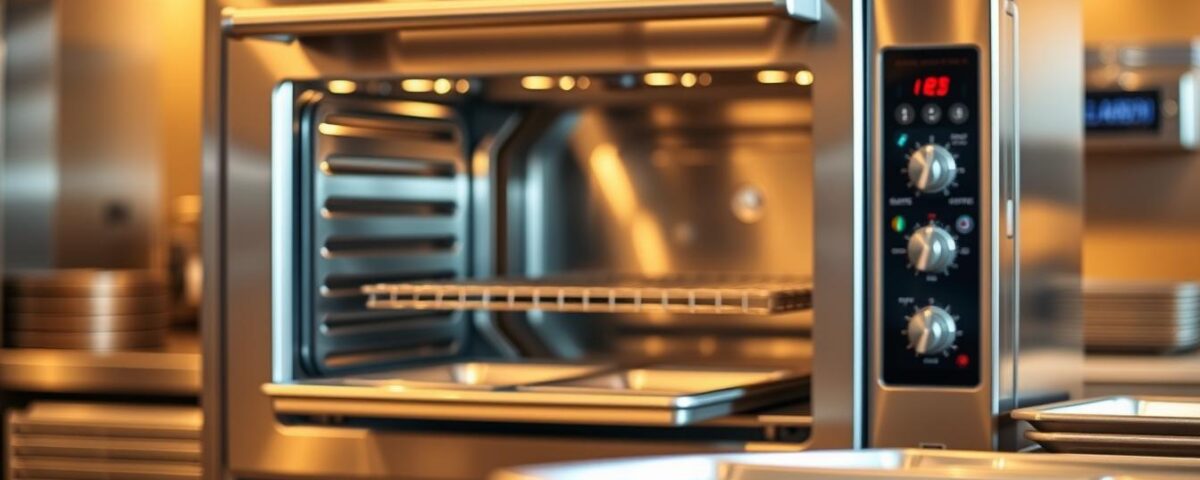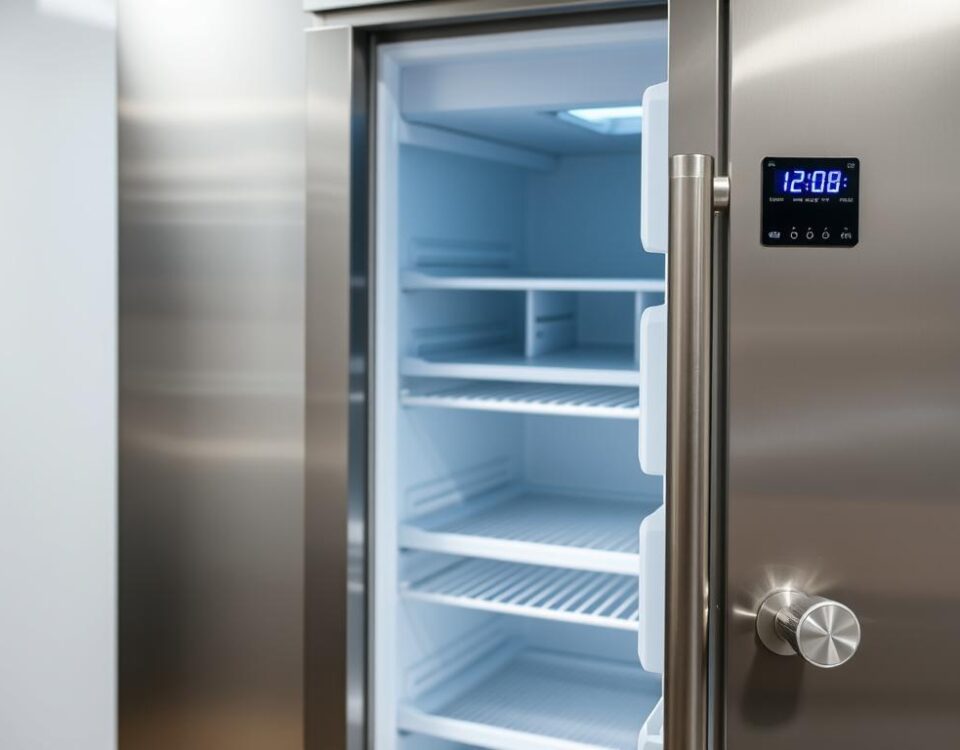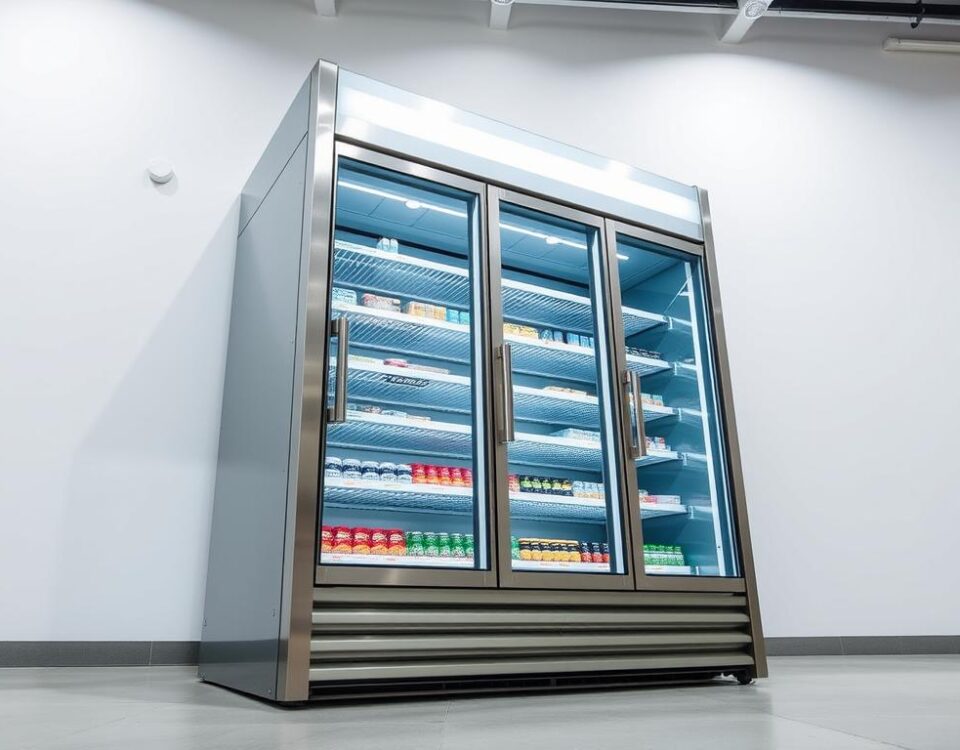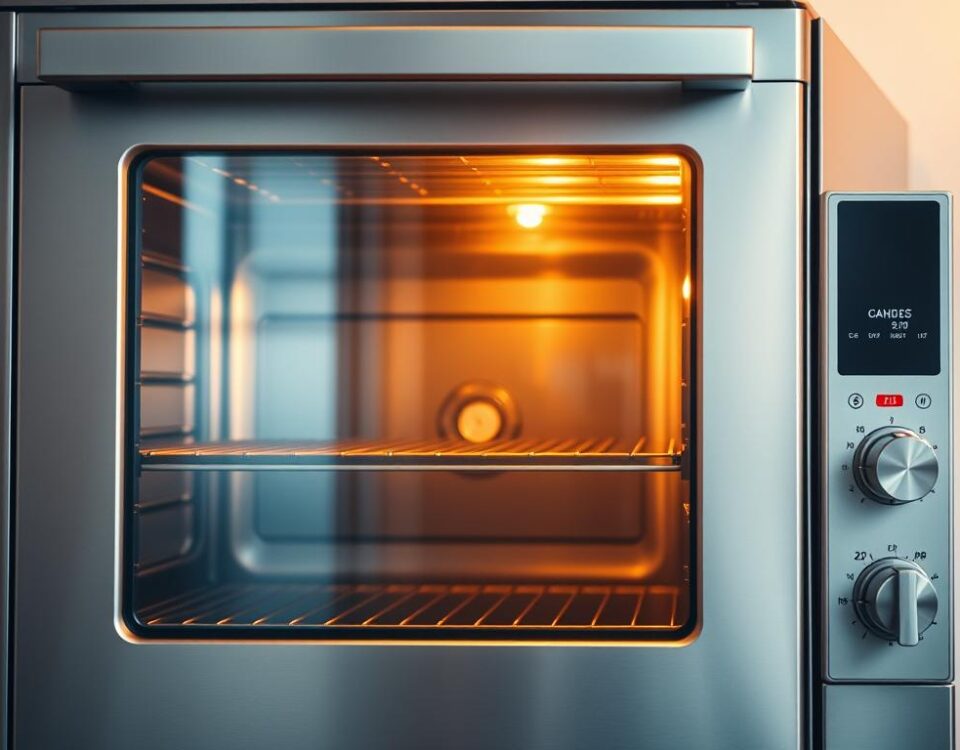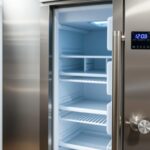
4 Mistakes Restaurants Make with Refrigerator & Freezer Temps
September 22, 2025As a food service business owner, finding the right convection oven can be a game-changer. I recall a busy Saturday night at a restaurant I frequented, where the kitchen staff struggled to keep up with orders due to their outdated cooking equipment. Did you know that using the right commercial cooking equipment can increase kitchen efficiency by up to 30%?
After testing five top-rated units, I’m excited to share my findings with you. From electric to gas and LPG options, I’ve put these ovens through their paces to help you make an informed decision for your business. What sets the top performers apart?
Key Takeaways
- Top-rated commercial convection ovens that excel in performance and efficiency.
- Key features to look for when selecting the best oven for your business needs.
- Insights from hands-on testing of various models and fuel types.
- Recommendations for different business needs and budgets.
- Understanding the differences between commercial convection oven types.
Understanding Commercial Convection Ovens
Commercial convection ovens have revolutionized the way we cook in commercial kitchens. These ovens use fans to circulate hot air throughout the oven cavity, ensuring even cooking and browning.
How Commercial Convection Ovens Work
The fundamental technology behind commercial convection ovens lies in their fan-forced air circulation system, which differs significantly from conventional ovens. The internal components, including heating elements and convection fans, work together to distribute heat evenly.
The even distribution of heat eliminates hot spots, ensuring consistent cooking results regardless of rack position. This is achieved through the precise control of air circulation patterns within the convection oven.
Benefits of Using Commercial Convection Ovens
Using a commercial convection oven offers several benefits, including reduced cooking times of up to 25%. This is because the circulating hot air cooks food more efficiently than traditional ovens.
- Improved food quality through even browning
- Enhanced kitchen productivity
- Better yield by reducing food shrinkage
- Eco-friendly operation through reduced energy consumption
Overall, commercial convection ovens are versatile workhorses used for roasting, baking, broiling, and more. Their ability to provide consistent results makes them an essential tool in many commercial kitchens.
My Testing Methodology
To ensure a comprehensive comparison, I developed a rigorous testing methodology for the commercial convection ovens. This approach allowed me to evaluate the performance, features, and usability of each unit.
Selection Criteria
I selected five commercial convection oven models based on market popularity, feature sets, and price points. This ensured a diverse range of units for comparison, from budget-friendly options to high-end models.
Testing Process
The testing process involved preparing identical food items across all units, including baked goods, roasted meats, and other common commercial kitchen items. I used temperature probes and energy meters to measure cooking times, temperature accuracy, heat distribution, and energy consumption.
Evaluation Metrics
I objectively scored each oven on performance, consistency, versatility, energy efficiency, build quality, and value for money. Both quantitative tests and qualitative assessments, such as taste tests and texture evaluation, were conducted to provide a complete picture of each oven’s capabilities.
By following this structured testing methodology, I was able to compare the commercial convection ovens effectively and provide a comprehensive review of their features and performance.
Types of Commercial Convection Ovens
Commercial convection ovens are not a one-size-fits-all solution; they come in several types, each designed for specific applications. Understanding these differences is key to selecting the right oven for your business.
Electric Convection Ovens
Electric convection ovens rely solely on electricity to operate, making them easy to install and versatile enough to fit into almost any kitchen setup. They are a convenient option, especially for businesses without existing gas connections. However, they may incur higher long-term energy costs, particularly for larger models that consume more electricity.
Gas Convection Ovens
Gas convection ovens, which use natural gas, heat up quicker than their electric counterparts and typically offer lower operational costs. They require both a gas connection and electricity to power the fans, lights, and controls. For kitchens already equipped with a gas connection, gas convection ovens can be a cost-effective choice.
LPG Convection Ovens
LPG (Liquefied Petroleum Gas) convection ovens provide an alternative to natural gas, offering greater efficiency, though at a higher fuel cost. They are ideal for locations where natural gas is not available. LPG convection ovens strike a balance between the benefits of gas convection cooking and the flexibility of not being tied to a natural gas supply.
Direct-Fired vs. Indirect-Fired Ovens
Another critical distinction among commercial convection ovens is between direct-fired and indirect-fired models. Direct-fired ovens have burners placed directly under the oven, delivering heat straight into the cooking chamber. This design is ideal for high-temperature baking, such as pizza and flatbreads. On the other hand, indirect-fired ovens prevent direct contact between the burner and the recirculated air, resulting in more consistent cooking outcomes, particularly for delicate items like pastries, cakes, and roasts.
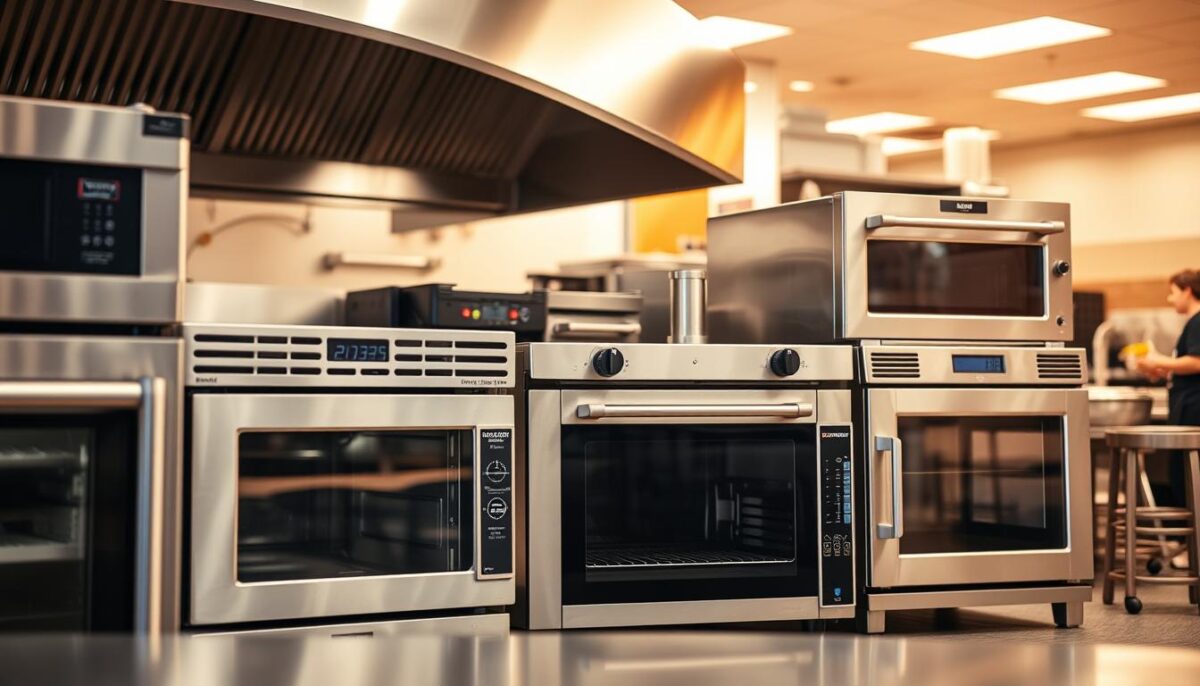
| Oven Type | Power Source | Key Benefits |
|---|---|---|
| Electric Convection Oven | Electricity | Easy to install, versatile |
| Gas Convection Oven | Natural Gas | Quick heat-up, lower operational costs |
| LPG Convection Oven | LPG | Greater efficiency, flexible installation |
| Direct-Fired Oven | Gas/Electricity | Ideal for high-temperature baking |
| Indirect-Fired Oven | Gas/Electricity | Consistent cooking results for delicate items |
Styles and Sizes of Commercial Convection Ovens
Commercial convection ovens come in a range of styles and sizes, each designed to meet specific kitchen needs. Whether you’re running a small café or a busy restaurant, understanding the different configurations available is key to optimizing your cooking operations.
Countertop Convection Ovens
Countertop convection ovens are designed for placement on countertops and are ideal for smaller commercial kitchens like concession stands, food trucks, small takeaways, and cafés. These ovens save valuable floor space, making them perfect for kitchens with limited room.
Floor Convection Ovens
Floor convection ovens, on the other hand, are ideal for high-volume kitchens. They come in compact models that fit well in kitchens with limited space, as well as larger models that can accommodate substantial food volumes. These ovens are designed for busy restaurants and bakeries where cooking capacity is crucial.
Single-Deck vs. Double-Deck Models
Single-deck convection ovens have one cooking compartment, while double-deck models have two decks, effectively doubling your cooking capacity without doubling your floor space requirements. This makes double-deck models highly efficient for kitchens that need to produce large quantities of food.
| Oven Size | Sheet Pan Capacity | Ideal For |
|---|---|---|
| Full Size | Standard 18″ x 26″ | High-volume kitchens, large restaurants |
| Half Size | 18″ x 13″ | Smaller kitchens, cafes |
| Quarter Size | 9½” x 13″ | Food trucks, concession stands |
By understanding the different styles and sizes of commercial convection ovens, you can make an informed decision that matches your business needs, kitchen space constraints, and production volume requirements.
Turbofan E27D3 Electric Convection Oven Review
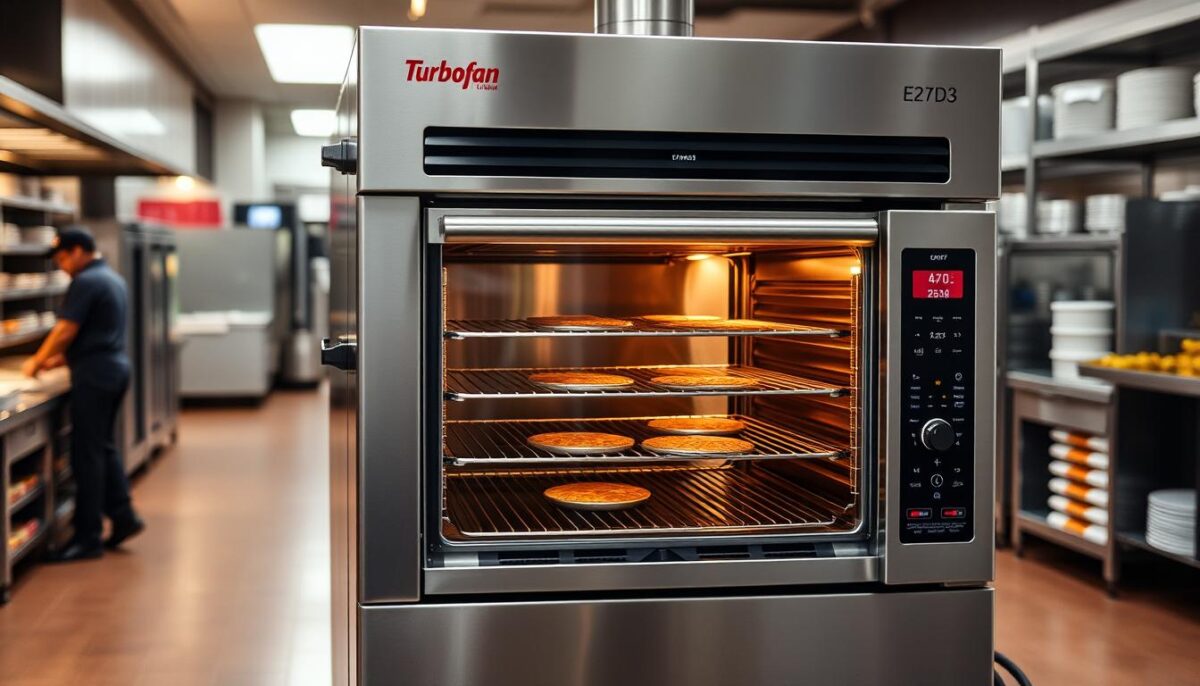
The Turbofan E27D3 Electric Convection Oven is a powerhouse in commercial kitchens, and my hands-on testing revealed its true capabilities. This full-size, commercial countertop electric convection oven is designed for modern commercial kitchens, making it ideal for smaller bakeries or front-of-house cooking in cafes and restaurants.
Key Features and Specifications
The Turbofan E27D3 boasts advanced features such as a bi-directional reversing fan system and a safe-touch vented drop-down door. It also has 20 programs with three-stage cooking, plus a stage-end alarm. Key specifications include dimensions (HxWxD) of 607mm x 810mm x 762mm, a capacity of 3 x 660mm x 460mm trays, a temperature range of 50°C-260°C, and steam injection capabilities. The oven requires 4.7kW of power, operating on a single-phase 20 Amp supply.
Performance Results
During my testing, the Turbofan E27D3 delivered excellent cooking performance, with consistent results across various dishes. The bi-directional reversing fan system ensured even cooking, while the programmable cooking stages allowed for versatile menu options. I was impressed with the oven’s ability to handle both baking and roasting tasks with ease.
Pros and Cons
The Turbofan E27D3 Electric Convection Oven has several advantages, including its excellent cooking performance and versatile programming options. However, it also has some drawbacks, such as a potential learning curve for programming and a higher price point. Overall, the benefits outweigh the drawbacks, making it a worthwhile investment for commercial kitchens.
UNOX Bakerlux Shop.Pro XEFT-10EU-ETRV Review
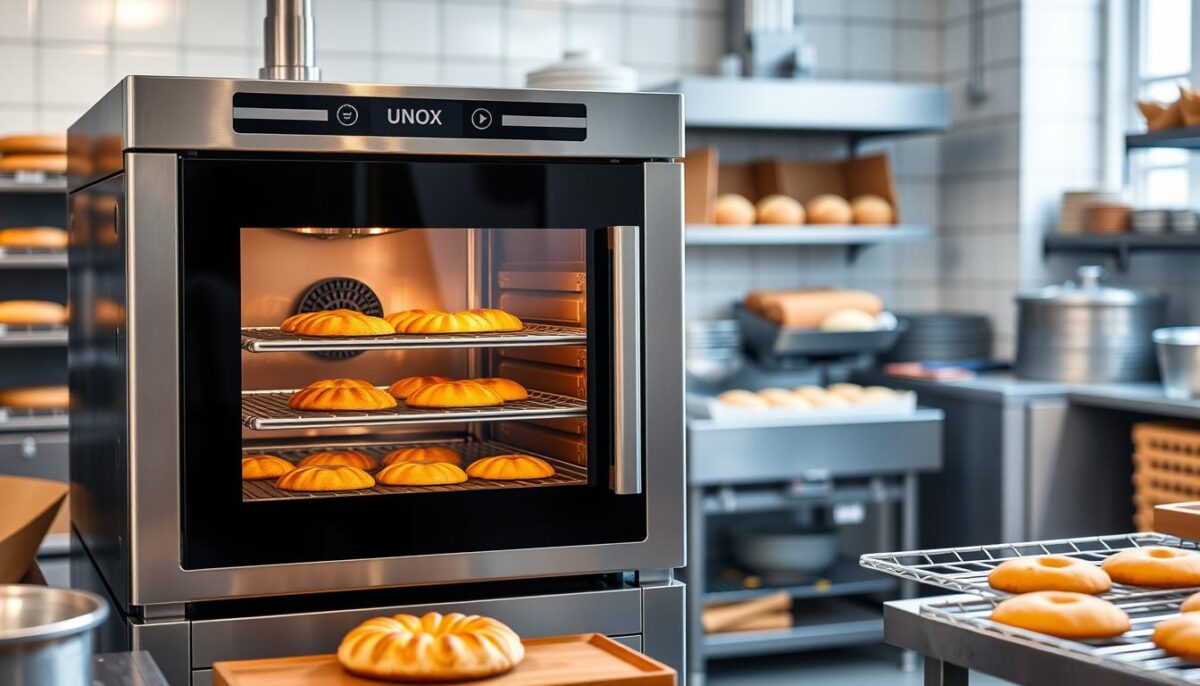
In my comprehensive review, I’ll share my findings on the UNOX Bakerlux Shop.Pro XEFT-10EU-ETRV, a sophisticated electric convection oven designed for professional bakeries and large-scale food services. This model boasts advanced features such as a 2.4″ touch control panel, automatic opening, and 99-program storage with up to nine cooking steps.
Key Features and Specifications
The UNOX Bakerlux Shop.Pro XEFT-10EU-ETRV is equipped with a substantial capacity, accommodating 10 trays of 600mm x 400mm. Its temperature range spans from 30°C to 260°C, and it operates on a single-phase 15 Amp connection with a powerful 15kW heating system. The oven’s dimensions (HxWxD) are 952mm x 800mm x 811mm, making it a considerable but worthwhile investment for serious bakery operations.
Performance Results
During testing, I evaluated the UNOX Bakerlux Shop.Pro XEFT-10EU-ETRV’s performance across various baking applications, including pastries, breakfast items, and frozen bakery products. The oven’s advanced humidity control system and proprietary cooking technologies (Dry.Plus, STEAM.Plus, and AIR.Plus) delivered exceptional results, showcasing its versatility and precision. The 99-program storage capability allowed for complex cooking sequences, demonstrating the oven’s flexibility in handling diverse culinary tasks.
Pros and Cons
The UNOX Bakerlux Shop.Pro XEFT-10EU-ETRV excels in cooking precision and versatile programming, making it an ideal choice for professional bakeries. However, its premium price point and potentially steep learning curve may deter some potential buyers. Despite these limitations, the oven’s performance and features justify its investment for operations seeking high-quality convection cooking.
Merrychef eikon e2s Classic Review
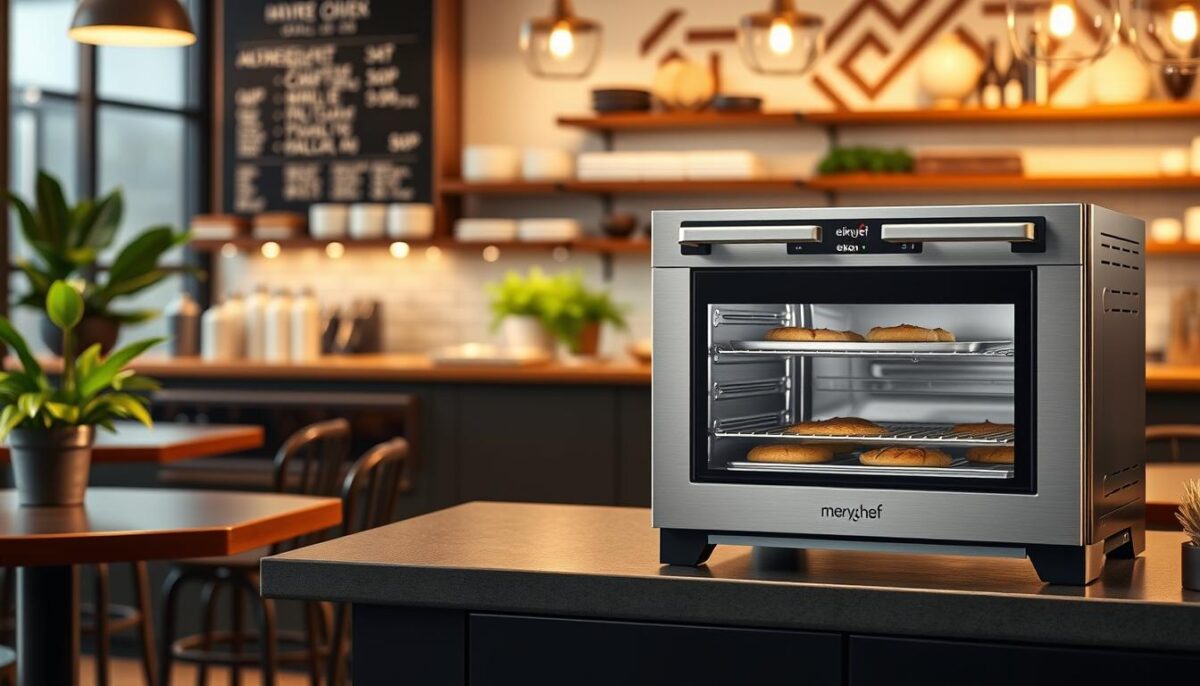
The Merrychef eikon e2s Classic is a compact, high-speed combination convection oven designed specifically for front-of-house operations in cafés, bistros, and fast-food establishments. I’ll be sharing my hands-on experience with this oven, focusing on its features, performance, and overall value.
Key Features and Specifications
This fully electric model boasts a range of innovative features, including user-definable temperature bandwidth, built-in diagnostic testing, and three heat technologies for rapid cooking. The oven has a compact design with dimensions of 61.9cm x 35.6cm x 59.4cm and a cooking capacity of 30.5cm x 30.5cm. It operates at 6kW with an energy efficiency of 0.7kW/h in standby mode, making it an efficient choice for busy kitchens.
Performance Results
In my testing, the Merrychef eikon e2s Classic convection technology delivered consistent and high-quality results across various food items. The oven’s performance was impressive, with rapid cooking times and a notable lack of noise during operation. The cool-to-touch exterior and front-mounted air filter added to its practicality in a front-of-house setting.
Pros and Cons
The Merrychef eikon e2s Classic offers several advantages, including its compact size, quiet operation, and cool-to-touch exterior. However, its smaller capacity and specialized applications may be considered drawbacks by some users. Overall, this oven is well-suited for establishments looking to enhance their front-of-house cooking capabilities.
In conclusion, the Merrychef eikon e2s Classic is a high-performing convection oven that excels in compact, high-speed cooking applications. Its innovative features and efficient operation make it a valuable addition to busy kitchens.
Turbofan G32D4 Gas Convection Oven Review
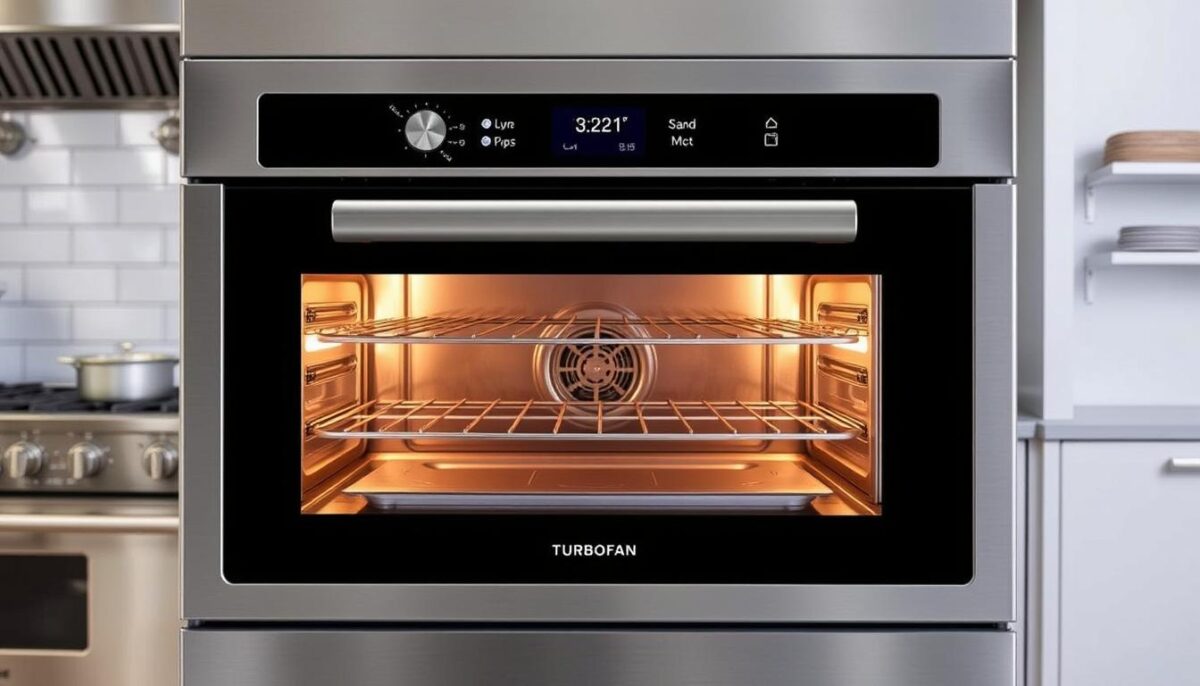
My hands-on experience with the Turbofan G32D4 gas convection oven revealed its capabilities as a powerful workhorse suitable for medium- to high-volume commercial kitchens. This programmable oven is designed to deliver high performance with its advanced features.
Key Features and Specifications
The Turbofan G32D4 gas convection oven boasts impressive specifications, including dimensions of 730mm x 610mm x 680mm and a capacity of 5 x 1/1 GN trays. It operates within a temperature range of 50°C to 260°C and features a two-speed, bi-directional reversing fan system. Additionally, it has a five-level moisture-injection mode with an electronic timer for precise control. The oven is powered by gas for heating and electricity for controls, making it a versatile option for various kitchen setups.
Performance Results
During my testing, the Turbofan G32D4 demonstrated excellent performance across various cooking applications. The programmable functions, including 20 programs with three-stage cooking, allowed for flexible and efficient cooking processes. I observed faster heat-up times compared to electric models, and the gas convection oven delivered consistent cooking results. The oven’s gas efficiency and cooking consistency were notable, making it a reliable choice for commercial kitchens.
Pros and Cons
The Turbofan G32D4 gas convection oven has several advantages, including its powerful performance and faster heat-up times. However, it also requires careful consideration of installation requirements and operational considerations. Overall, the benefits of this oven make it a strong contender for kitchens looking to upgrade their cooking capabilities.
UNOX Bakerlux Shop.Pro XEFT-30EU-ELDV Review
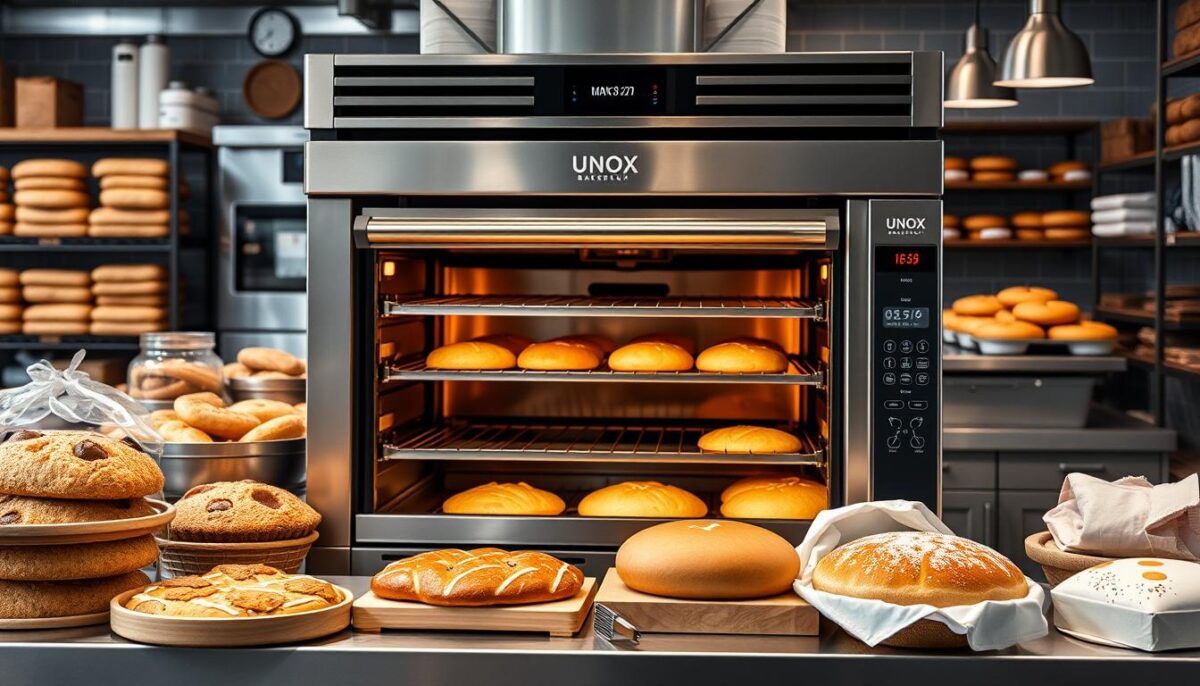
I’ll be sharing my hands-on experience with the UNOX Bakerlux Shop.Pro XEFT-30EU-ELDV, a compact electric convection oven designed for smaller bakeries and food service operations. This advanced oven boasts two programmable fan speeds and UNOX’s patented cooking technologies — Dry.Plus, STEAM.Plus, and AIR.Plus — to ensure the best quality every time.
Key Features and Specifications
The UNOX Bakerlux Shop.Pro XEFT-30EU-ELDV has several key features that make it stand out. It has a capacity for 3 x 600mm x 400mm trays, a temperature range of 30°C-260°C, and modest power requirements of 3kW, single phase 15 Amp. The oven’s dimensions (HxWxD) are 425mm x 800mm x 811mm, making it a compact addition to any kitchen.
Performance Results
In my testing, I evaluated the performance of the UNOX Bakerlux Shop.Pro XEFT-30EU-ELDV across various baking applications. The oven’s programmable features allowed me to store up to 99 programs, each with three cooking steps. The two-speed fan system performed well with different food items, and the results were consistently excellent.
I was impressed by the oven’s ability to deliver high-quality baking results, thanks to its advanced cooking technologies. The Dry.Plus, STEAM.Plus, and AIR.Plus features worked seamlessly together to produce perfectly cooked dishes.
Pros and Cons
The UNOX Bakerlux Shop.Pro XEFT-30EU-ELDV offers several advantages, including its compact size, advanced features, and excellent baking results. However, it’s not without its limitations. The capacity may be restrictive for larger operations, and the price relative to its size may be a consideration for some buyers.
Overall, the UNOX Bakerlux Shop.Pro XEFT-30EU-ELDV is a sophisticated convection oven that is well-suited to smaller bakeries and food service operations. Its advanced features and excellent performance make it a valuable addition to any kitchen.
The Best Commercial Convection Oven
After testing multiple units, I’m excited to reveal the best commercial convection oven that stood out from the rest. My comprehensive testing has allowed me to compare various models based on performance, features, and value, providing a clear picture of which convection oven reigns supreme.
Overall Winner
The Turbofan E27D3 Electric Convection Oven emerged as the overall winner in my tests. Its exceptional performance, combined with advanced features like precise temperature control and a robust turbofan system, made it stand out. This oven delivered consistent results across various cooking tasks, making it ideal for busy commercial kitchens.
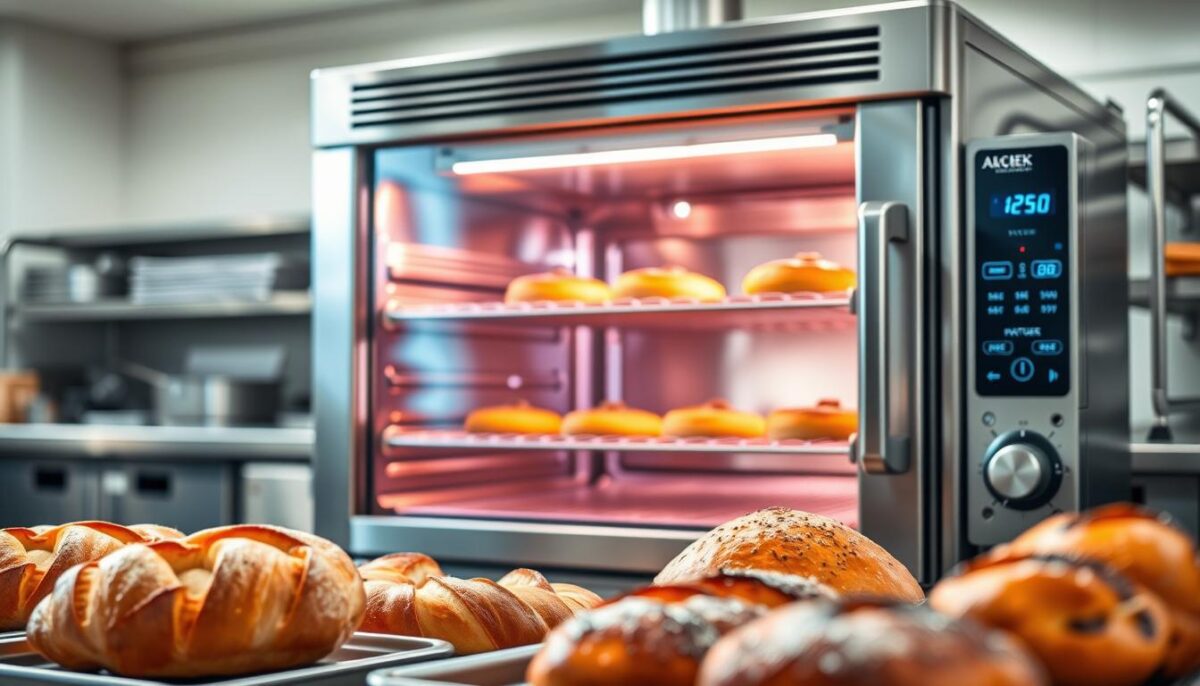
Runner-Up
The UNOX Bakerlux Shop.Pro XEFT-10EU-ETRV was a close second. It nearly matched the top performer in terms of cooking quality and featured an intuitive interface. While it wasn’t perfect, this model is a strong contender, especially for businesses that value its unique features, such as advanced humidity control.
Best Budget Option
For those on a tighter budget, the Merrychef eikon e2s Classic offers the best value. It includes many premium features at a lower price point, although it makes some compromises on advanced functionalities. This convection oven is perfect for small to medium-sized businesses looking for reliability without breaking the bank.
When choosing the best commercial convection oven for your business, consider your specific needs, including the type of food you produce and your kitchen’s space constraints. Whether you’re a bakery, restaurant, or café, there’s a model out there that’s right for you.
Key Factors to Consider When Buying a Commercial Convection Oven
The process of selecting the ideal commercial convection oven involves evaluating multiple crucial elements. As a business owner, it’s essential to consider these factors to ensure that your investment meets your cooking needs and provides long-term value.
Food Type and Volume
Before ordering a convection oven, consider the type of food you’ll be preparing, as some types are more suitable for specific foods. The quantity of food you need to cook will determine the size and power requirements of the oven. For instance, if you’re cooking large quantities, you’ll need a more powerful oven to ensure efficient cooking.
Kitchen Space and Installation Requirements
Consider your kitchen layout, ease of access, and installation requirements, including electric plug points and ventilation needs. Ensure that the oven you choose fits comfortably in your kitchen and can be installed without significant modifications.
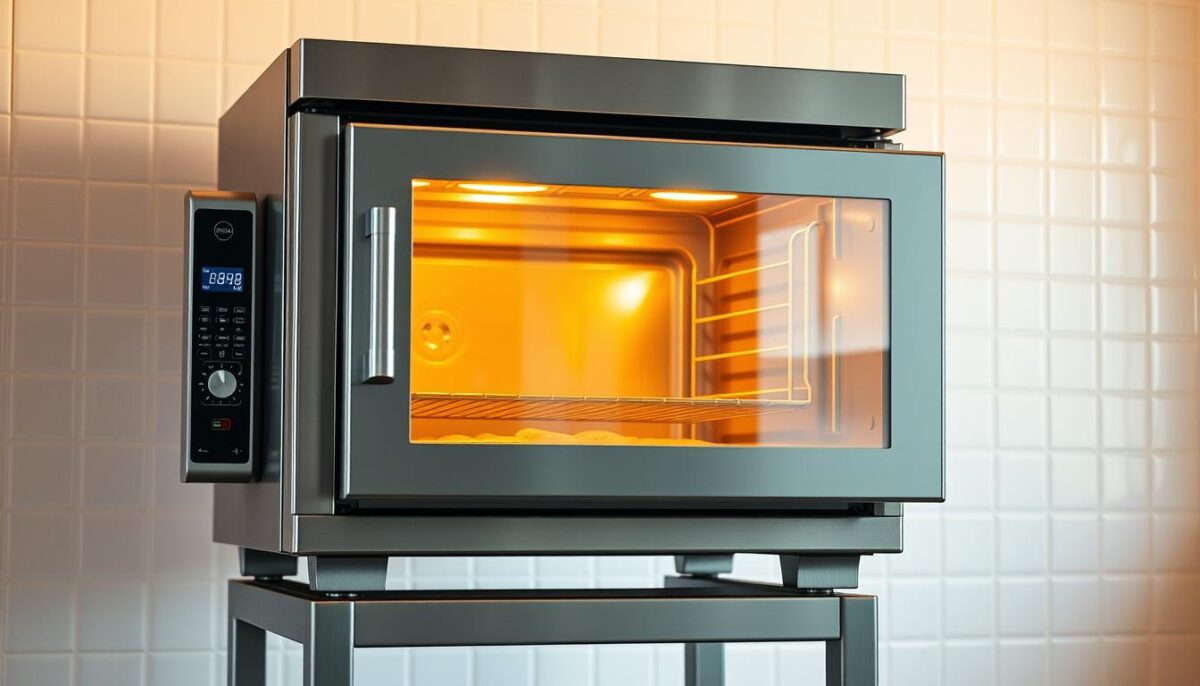
Energy Efficiency and Operating Costs
Energy-efficient ovens may cost more initially but can save money over time. Look for ovens with ENERGY STAR certification, which indicates that they meet energy efficiency standards. For example, ENERGY STAR certified gas convection ovens have at least 49% cooking energy efficiency, while electric convection ovens have at least 71% (half-size) or 76% (full-size) cooking energy efficiency.
Safety Features and Certifications
When selecting a commercial convection oven, it’s crucial to consider safety features such as anti-skid feet, overheating safety cut-out, stay-cool handles, and safe-touch exteriors. Additionally, look for ovens that meet industry standards and have relevant certifications. These features will help ensure a safe working environment and prevent accidents.
By carefully evaluating these key factors, you can make an informed decision when buying a commercial convection oven that meets your business needs and provides long-term value.
Convection Oven Controls and Special Features
The right controls and features can make a significant difference in the performance of a commercial convection oven. When selecting a commercial convection oven, it’s essential to consider the type of controls and special features that will best suit your needs.
Manual vs. Digital Controls
Commercial convection ovens come with either manual or digital controls. Manual controls allow you to select the desired temperature and cook time at the press of a few buttons, providing simplicity and reliability. Digital controls, on the other hand, enable you to pre-set the temperature and cooking time for dishes, ensuring consistency regardless of who is cooking. In my testing experience, digital controls offered greater precision and programmability, making them ideal for high-volume kitchens.
Fan Speed Options
Most industrial convection ovens have at least two fan-speed settings: high and low. High fan speed is used for dense foods like roasts and casseroles, while low fan speed is better for delicate items like pastries and breads. Some models feature fans that change direction when the door is opened or can circulate air in two directions, ensuring even cooking. The importance of fan speed options cannot be overstated, as they directly affect cooking results for different food items.
Premium Features Worth the Investment
Premium features like automatic temperature and cooking time adjustment for different recipes, cook-and-hold functionality, and steam injection can significantly enhance the performance of a commercial convection oven. Some models even offer pre-set controls for over 200 recipes. While these features may add cost, they can improve kitchen efficiency and food quality. It’s crucial to distinguish between genuinely useful innovations and marketing gimmicks that add cost without significant benefit.
Maintenance and Cleaning Tips
Proper care and maintenance can significantly extend the life of your convection oven. Regular cleaning is essential to prevent the buildup of food residue and ensure consistent cooking performance. As I’ve learned from testing multiple commercial convection ovens, a well-maintained oven is not only more efficient but also safer to use.
Daily Cleaning Procedures
Daily cleaning is crucial to maintaining your convection oven. Start by removing and washing the racks and trays with soap and warm water. The oven cavity should be wiped down with a damp cloth, paying particular attention to the areas around the heating elements and fans. For tougher grime, a mixture of baking soda and water can be used to create a paste that helps break down the residue.
“Regular cleaning can add years to the life of your commercial convection oven and safeguard food hygiene,” as emphasized by industry experts. Look for models with removable racks and enamelled interiors, as these features make cleaning easier.
Long-Term Maintenance Schedule
In addition to daily cleaning, a long-term maintenance schedule is necessary to prevent costly repairs and ensure optimal performance. This includes weekly checks on the door seals and hinges, monthly cleaning of the fans and heating elements, and quarterly deep cleaning of the oven cavity. It’s also important to know when to call in professional service technicians versus what maintenance tasks you can safely perform in-house.
By following these maintenance and cleaning tips, you can extend the life of your convection oven and ensure it continues to perform at its best.
Commercial Convection Oven Pricing Guide
Commercial convection ovens come in a range of prices, and understanding these differences is key to finding the right oven for your business. The cost of a new commercial convection oven can vary widely, from around $700 to over $17,000, depending on the make, model, and features.
When determining your budget, it’s essential to consider not only the initial purchase price but also incidental costs such as delivery and installation, which can vary based on the oven’s size and complexity. Additionally, you may need to budget for accessories like stacking kits or wire racks.
Budget Models ($700-$3,000)
Budget-friendly models, such as the Apuro compact 21-litre convection oven, are available for around $750. These entry-level ovens are ideal for small businesses or those with limited kitchen space. However, they may lack some advanced features and have lower durability compared to more expensive models.
Mid-Range Models ($3,000-$10,000)
The mid-range category offers a balance of performance, durability, and value. Ovens in this price range often come with advanced features like digital controls and multiple cooking modes. They are suitable for businesses with moderate cooking demands.
Premium Models ($10,000+)
Premium commercial convection ovens, like the UNOX Bakerlux 16-tray electric convection oven, which costs around $16,800, offer advanced features, high durability, and superior performance. These models are ideal for large-scale commercial kitchens or businesses that require precise temperature control and high-volume cooking capabilities.
| Price Range | Features | Target Business |
|---|---|---|
| $700-$3,000 | Basic features, compact design | Small businesses, limited kitchen space |
| $3,000-$10,000 | Advanced features, digital controls | Moderate cooking demands |
| $10,000+ | High-end features, high durability | Large commercial kitchens, high-volume cooking |
By understanding the different pricing tiers and what they offer, you can make an informed decision that meets your business needs and budget.
Conclusion
Having put five commercial convection ovens through rigorous testing, I’m now ready to present my conclusions and recommendations. After evaluating their performance, features, and overall value, it’s clear that some models stand out from the rest.
The Turbofan E27D3 Electric Convection Oven emerged as the top choice for its exceptional cooking consistency, ease of use, and robust construction. For businesses with different needs, such as small cafés or large-scale bakeries, this model proved to be highly versatile and efficient.
When deciding to invest in a commercial convection oven, consider factors such as the type of food you cook, available kitchen space, and energy efficiency. Upgrading to a commercial convection oven makes sense when you need to increase cooking volume or improve food quality. Replacing an aging unit is advisable when repair costs become prohibitive or when newer models offer significant performance enhancements.
To make an informed purchase decision, I recommend researching specific models, arranging demonstrations, and comparing features. By doing so, you’ll be able to select the best commercial convection oven that meets your business needs and enhances your kitchen’s productivity.
In conclusion, investing in the right commercial convection oven can significantly impact your kitchen’s efficiency and food quality. By considering your specific needs and exploring the available options, you can make a well-informed decision that benefits your business in the long run.
FAQ
What is the difference between electric and gas convection ovens?
Electric convection ovens use electricity to heat elements, while gas convection ovens use natural gas or LPG to produce heat. Electric ovens are generally easier to install, while gas ovens offer more precise temperature control.
What are the benefits of using a convection oven in a bakery?
Convection ovens help to cook baked goods more evenly and quickly, resulting in a crispy exterior and a tender interior. They also allow for more efficient cooking, reducing energy costs and increasing productivity.
Can I use a convection oven for cooking pizza?
Yes, convection ovens are ideal for cooking pizza. They help to cook the crust quickly and evenly, resulting in a crispy crust and well-cooked toppings.
What is the difference between a single-deck and double-deck convection oven?
A single-deck convection oven has one cooking compartment, while a double-deck oven has two. Double-deck ovens are ideal for high-volume cooking, but require more kitchen space and energy.
How do I clean and maintain my convection oven?
Regular cleaning involves wiping down the exterior and interior with a damp cloth, while deep cleaning requires a more thorough scrubbing of the oven cavity and racks. Refer to your user manual for specific cleaning instructions.
What are the safety features I should look for in a convection oven?
Look for ovens with automatic shut-off, child safety locks, and heat-resistant handles. Also, ensure that the oven is certified by a reputable testing organization, such as UL or ETL.
Can I use LPG with my convection oven?
Yes, some convection ovens are designed to run on LPG. Check your user manual or manufacturer’s specifications to confirm compatibility.
What is the typical price range for a convection oven?
Convection oven prices vary widely, from around 0 for budget models to over ,000 for premium models. Mid-range models typically fall between ,000 and ,000.
